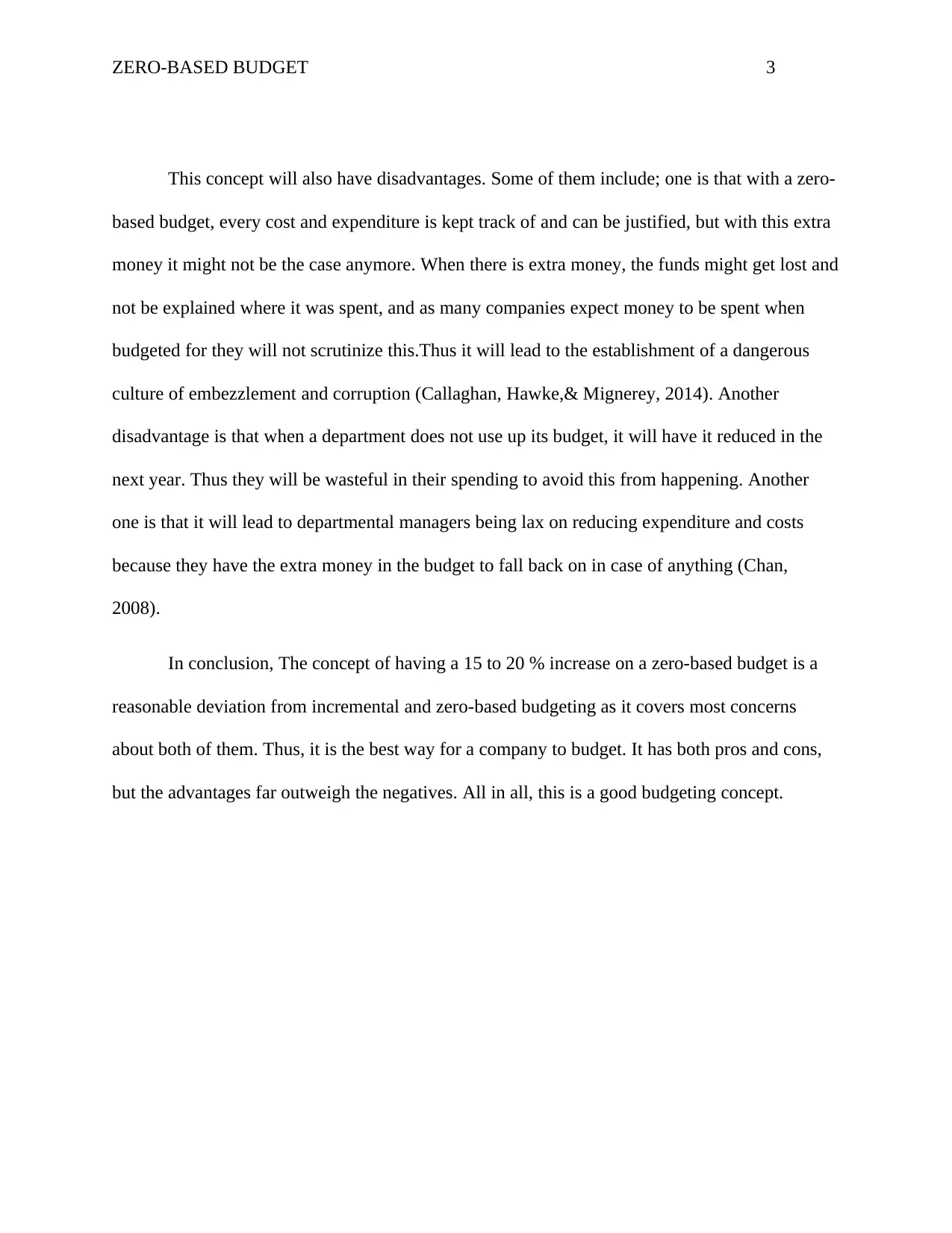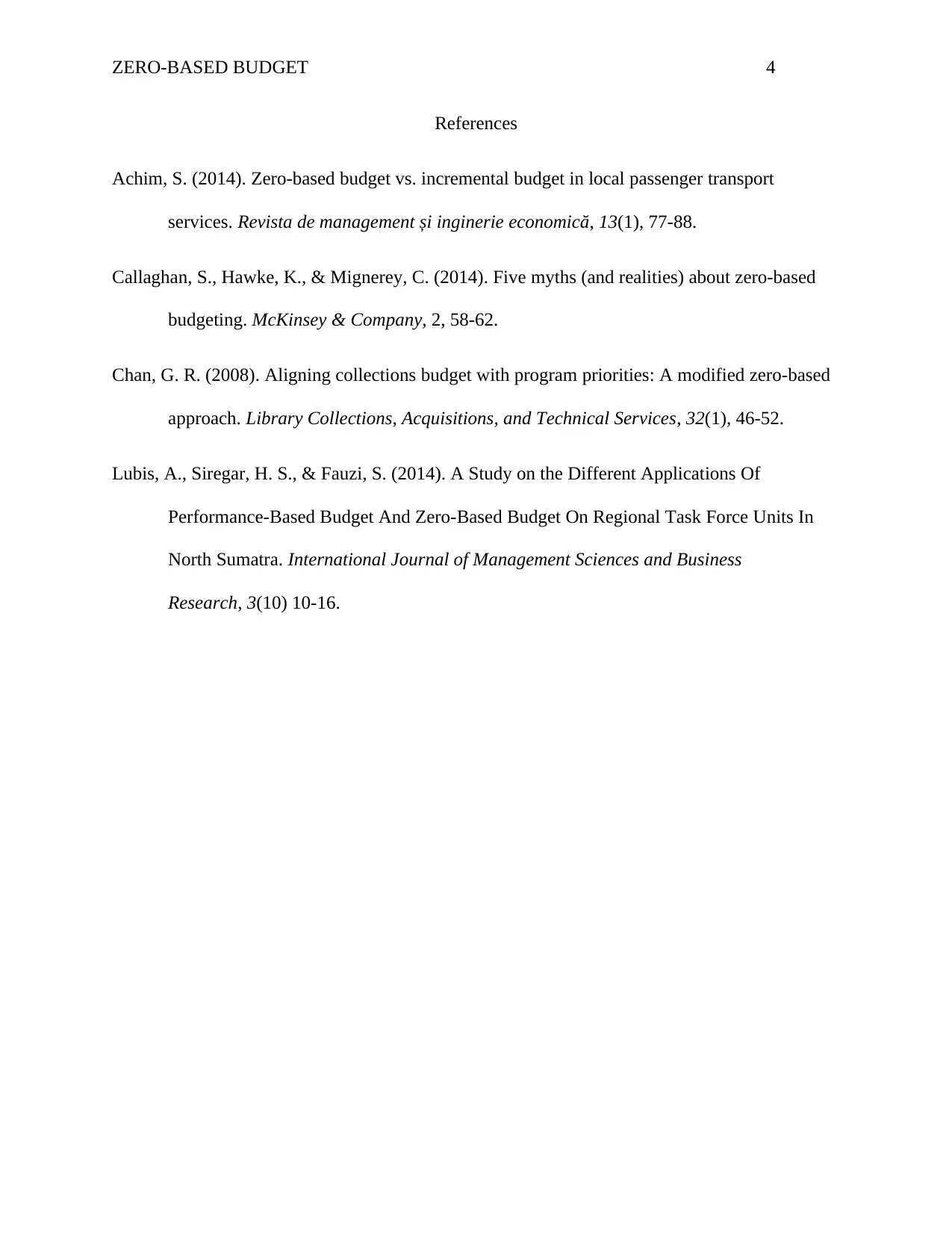Zero-Based Budget: Advantages and Disadvantages of Contingency Funds
VerifiedAdded on 2021/04/17
|4
|811
|247
Report
AI Summary
This report provides an in-depth analysis of zero-based budgeting (ZBB), a financial technique where all expenditures are justified each budget year from a "zero base." It examines the practice of adding a 15-20% increment to a ZBB to account for unforeseen expenses, exploring the advantages such as covering unexpected costs and streamlining the budgeting process, and disadvantages like potential mismanagement of funds and reduced departmental cost-cutting incentives. The report concludes that while the concept has both pros and cons, the benefits of using contingency funds in ZBB outweigh the negatives, making it a valuable approach for effective financial planning and management. The report references several academic articles to support its findings.

Running head: ZERO-BASED BUDGET 1
Zero-Based Budget
Name
Institutional Affiliation
Zero-Based Budget
Name
Institutional Affiliation
Paraphrase This Document
Need a fresh take? Get an instant paraphrase of this document with our AI Paraphraser

ZERO-BASED BUDGET 2
Zero-based budget
Zero-based budgeting (ZBB) is a technique of accounting where all expenditures must be
accounted for every new budget year. The procedure of zero-based budgeting beginnings from a
"zero base," and each role in a company is examined for its requirements and expenses. Budgets
are then made with all elements in mind for the new budget year, with no thought on whether it
is higher or lower than the previous one. Instead of thoughtlessly enhancing the budget by a
particular amount and covering the expenses added, the organization can recognize a
circumstance where it can choose to manufacture the required part on its own or purchase is from
the outside dealer for the final goods. Thus, zero-based budgeting purposes to detect and validate
expenses. This paper will discuss the concept of adding 15-20% to a zero-based budget to protect
against unforeseen expenditures in depth; this is having extra cash in the budget in case anything
goes wrong. It will look at the pros and cons of this concept (Lubis, Siregar, & Fauzi, 2014).
The concept of business adding to their zero-based budget a 15-20% increment is done
for various reasons. It is done mostly as a way of cushioning it if it goes into crisis during the
budget year. When the company decides to take this route, it can end up facing various positives
and negatives as a result. The advantages of this concept include, The company will be able to
shelter any additional costs they may not have foreseen while doing the budget for that year.
Hence they will not have to scramble to find ways to cover the costs as you have the extra money
at hand (Callaghan, Hawke, & Mignerey, 2014). Another advantage is that when preparing this
budget, it will not be as time-consuming as making the zero-based budget as it will not have to
go into in-depth details. The extra 15 to 20 % will cover any additional expenses that may come
up. Thus this will be easier to understand and have less paperwork while preparing it (Achim,
2014).
Zero-based budget
Zero-based budgeting (ZBB) is a technique of accounting where all expenditures must be
accounted for every new budget year. The procedure of zero-based budgeting beginnings from a
"zero base," and each role in a company is examined for its requirements and expenses. Budgets
are then made with all elements in mind for the new budget year, with no thought on whether it
is higher or lower than the previous one. Instead of thoughtlessly enhancing the budget by a
particular amount and covering the expenses added, the organization can recognize a
circumstance where it can choose to manufacture the required part on its own or purchase is from
the outside dealer for the final goods. Thus, zero-based budgeting purposes to detect and validate
expenses. This paper will discuss the concept of adding 15-20% to a zero-based budget to protect
against unforeseen expenditures in depth; this is having extra cash in the budget in case anything
goes wrong. It will look at the pros and cons of this concept (Lubis, Siregar, & Fauzi, 2014).
The concept of business adding to their zero-based budget a 15-20% increment is done
for various reasons. It is done mostly as a way of cushioning it if it goes into crisis during the
budget year. When the company decides to take this route, it can end up facing various positives
and negatives as a result. The advantages of this concept include, The company will be able to
shelter any additional costs they may not have foreseen while doing the budget for that year.
Hence they will not have to scramble to find ways to cover the costs as you have the extra money
at hand (Callaghan, Hawke, & Mignerey, 2014). Another advantage is that when preparing this
budget, it will not be as time-consuming as making the zero-based budget as it will not have to
go into in-depth details. The extra 15 to 20 % will cover any additional expenses that may come
up. Thus this will be easier to understand and have less paperwork while preparing it (Achim,
2014).

ZERO-BASED BUDGET 3
This concept will also have disadvantages. Some of them include; one is that with a zero-
based budget, every cost and expenditure is kept track of and can be justified, but with this extra
money it might not be the case anymore. When there is extra money, the funds might get lost and
not be explained where it was spent, and as many companies expect money to be spent when
budgeted for they will not scrutinize this.Thus it will lead to the establishment of a dangerous
culture of embezzlement and corruption (Callaghan, Hawke,& Mignerey, 2014). Another
disadvantage is that when a department does not use up its budget, it will have it reduced in the
next year. Thus they will be wasteful in their spending to avoid this from happening. Another
one is that it will lead to departmental managers being lax on reducing expenditure and costs
because they have the extra money in the budget to fall back on in case of anything (Chan,
2008).
In conclusion, The concept of having a 15 to 20 % increase on a zero-based budget is a
reasonable deviation from incremental and zero-based budgeting as it covers most concerns
about both of them. Thus, it is the best way for a company to budget. It has both pros and cons,
but the advantages far outweigh the negatives. All in all, this is a good budgeting concept.
This concept will also have disadvantages. Some of them include; one is that with a zero-
based budget, every cost and expenditure is kept track of and can be justified, but with this extra
money it might not be the case anymore. When there is extra money, the funds might get lost and
not be explained where it was spent, and as many companies expect money to be spent when
budgeted for they will not scrutinize this.Thus it will lead to the establishment of a dangerous
culture of embezzlement and corruption (Callaghan, Hawke,& Mignerey, 2014). Another
disadvantage is that when a department does not use up its budget, it will have it reduced in the
next year. Thus they will be wasteful in their spending to avoid this from happening. Another
one is that it will lead to departmental managers being lax on reducing expenditure and costs
because they have the extra money in the budget to fall back on in case of anything (Chan,
2008).
In conclusion, The concept of having a 15 to 20 % increase on a zero-based budget is a
reasonable deviation from incremental and zero-based budgeting as it covers most concerns
about both of them. Thus, it is the best way for a company to budget. It has both pros and cons,
but the advantages far outweigh the negatives. All in all, this is a good budgeting concept.
⊘ This is a preview!⊘
Do you want full access?
Subscribe today to unlock all pages.

Trusted by 1+ million students worldwide

ZERO-BASED BUDGET 4
References
Achim, S. (2014). Zero-based budget vs. incremental budget in local passenger transport
services. Revista de management și inginerie economică, 13(1), 77-88.
Callaghan, S., Hawke, K., & Mignerey, C. (2014). Five myths (and realities) about zero-based
budgeting. McKinsey & Company, 2, 58-62.
Chan, G. R. (2008). Aligning collections budget with program priorities: A modified zero-based
approach. Library Collections, Acquisitions, and Technical Services, 32(1), 46-52.
Lubis, A., Siregar, H. S., & Fauzi, S. (2014). A Study on the Different Applications Of
Performance-Based Budget And Zero-Based Budget On Regional Task Force Units In
North Sumatra. International Journal of Management Sciences and Business
Research, 3(10) 10-16.
References
Achim, S. (2014). Zero-based budget vs. incremental budget in local passenger transport
services. Revista de management și inginerie economică, 13(1), 77-88.
Callaghan, S., Hawke, K., & Mignerey, C. (2014). Five myths (and realities) about zero-based
budgeting. McKinsey & Company, 2, 58-62.
Chan, G. R. (2008). Aligning collections budget with program priorities: A modified zero-based
approach. Library Collections, Acquisitions, and Technical Services, 32(1), 46-52.
Lubis, A., Siregar, H. S., & Fauzi, S. (2014). A Study on the Different Applications Of
Performance-Based Budget And Zero-Based Budget On Regional Task Force Units In
North Sumatra. International Journal of Management Sciences and Business
Research, 3(10) 10-16.
1 out of 4
Related Documents
Your All-in-One AI-Powered Toolkit for Academic Success.
+13062052269
info@desklib.com
Available 24*7 on WhatsApp / Email
![[object Object]](/_next/static/media/star-bottom.7253800d.svg)
Unlock your academic potential
Copyright © 2020–2025 A2Z Services. All Rights Reserved. Developed and managed by ZUCOL.




![Financial Analysis and Investment Appraisal Report - [University Name]](/_next/image/?url=https%3A%2F%2Fdesklib.com%2Fmedia%2Fimages%2Fns%2F9acd7be543d74925b8f603b3e255ec84.jpg&w=256&q=75)
